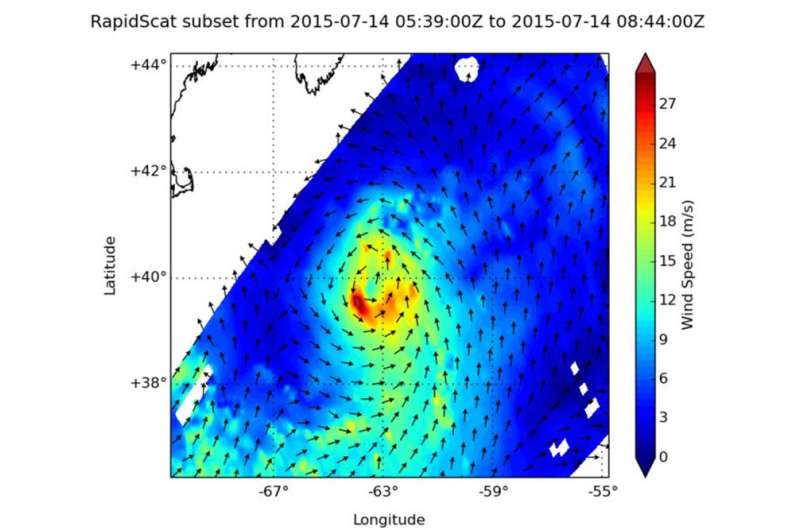RapidScat shows a dying Post-Tropical Storm Claudette

NASA's RapidScat instrument saw that Post-Tropical Storm Claudette's winds were waning with the exception of those in its southwestern quadrant.
RapidScat is an instrument that is perched on the International Space Station and provides measurements of surface winds over the ocean. When the International Space Station flew over Post-Tropical Storm Claudette on July 14, RapidScat measured the surface winds associated with the storm from 5:39 to 8:44 UTC (1:39 to 4:44 a.m. EDT). RapidScat saw that sustained winds surrounding the center of circulation were no stronger than 21 meters per second (m/s) (46.9 mph/ 75.6 kph) with the exception of the southwestern quadrant of the storm. In that quadrant, sustained winds were near 29 m/s (64.8 mph/104.4 kph).
On July 15 at 0300 UTC (July 14 at 11 p.m. EDT), the National Hurricane Center (NHC) issued the final advisory on Post-Tropical Cyclone Claudette. At that time the center of the post-tropical cyclone was located near latitude 43.8 North and longitude 57.8 West. Claudette had maximum sustained winds near 40 knots (45 mph/75 kph), however, NHC noted that the winds and seas vary greatly in each quadrant.
NHC Forecaster Cangialosi noted that "Claudette has lacked organized deep convection for nearly 10 hours now, and it only consists of a swirl of low-level clouds. The cyclone is currently over [cold] sea surface temperatures near 17 Celsius (62.6 Fahrenheit), so it is highly unlikely that significant thunderstorm activity will return. Therefore, Claudette is considered a post-tropical cyclone."
Tropical cyclones need sea surface temperatures of at least 26.6 Celsius (80 Fahrenheit) to maintain intensity. The much colder sea surface temperatures that Claudette was moving through was quickly weakening the storm.
Claudette will continue to move in a northeasterly direction until it dissipates over the Northern Atlantic Ocean late on July 15.
Provided by NASA's Goddard Space Flight Center



















